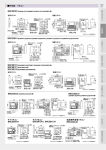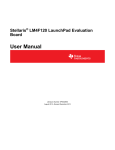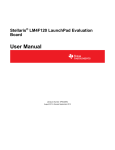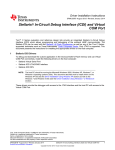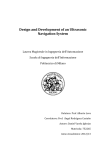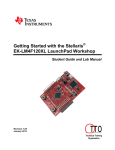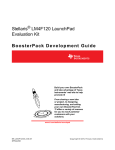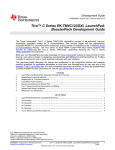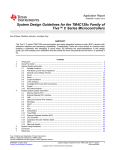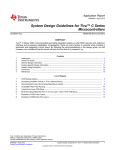Download DK-TM4C129X User`s Guide
Transcript
Tiva™ TM4C129X Development Board User's Guide Literature Number: SPMU360 October 2013 Contents 1 DK-TM4C129X Overview 1.1 1.2 1.3 1.4 2 Hardware Description 2.1 3 ...................................................................................................... 4 Kit Contents .................................................................................................................. Using the DK-TM4C129X .................................................................................................. Features ...................................................................................................................... Specifications ................................................................................................................ 5 5 5 6 .......................................................................................................... 7 Functional Description ...................................................................................................... 8 2.1.1 Microcontroller ...................................................................................................... 8 2.1.2 Clocking ............................................................................................................. 8 2.1.3 Reset ................................................................................................................ 8 2.1.4 Debugging and Programming .................................................................................... 8 2.1.5 Power ................................................................................................................ 9 2.1.6 USB Host/Device/OTG .......................................................................................... 10 2.1.7 User Buttons and User LED .................................................................................... 10 2.1.8 Headers ............................................................................................................ 11 2.1.9 Speaker ............................................................................................................ 14 2.1.10 EEPROM and SD Card ......................................................................................... 14 2.1.11 Temperature Sensor ............................................................................................ 15 2.1.12 LCD ............................................................................................................... 15 2.1.13 Ethernet ........................................................................................................... 17 2.1.14 Hibernation ....................................................................................................... 17 Software Development ....................................................................................................... 18 Software Description ...................................................................................................... Source Code ............................................................................................................... Tool Options ................................................................................................................ Programming the DK-TM4C129X Board ............................................................................... 18 18 18 18 20 D ........................................................................................................ Bill of Materials (BOM) ....................................................................................................... References ....................................................................................................................... Schematics ....................................................................................................................... 2 Contents 3.1 3.2 3.3 3.4 A B C Component Locations 23 27 28 SPMU360 – October 2013 Submit Documentation Feedback Copyright © 2013, Texas Instruments Incorporated www.ti.com List of Figures 1-1. Board Picture ................................................................................................................ 4 2-1. DK-TM4C129X Development Board Block Diagram ................................................................... 7 2-2. Booster Pack 1............................................................................................................. 11 2-3. Booster Pack 2............................................................................................................. 12 2-4. ULPI, MII, and RMII ....................................................................................................... 13 2-5. Resistive Touch Screen .................................................................................................. 16 2-6. LCD Pin Out ................................................................................................................ 16 A-1. DK-TM4C129X Component Locations (Top View) .................................................................... 20 A-2. DK-TM4C129X Component Locations (Bottom View) ................................................................ 21 A-3. Jumper and Shunt Locations ............................................................................................ 22 List of Tables 1-1. DK-TM4C129X Specifications ............................................................................................. 2-1. JTAG Pin Table ............................................................................................................. 9 2-2. USB Host/Device/OTG Signals .......................................................................................... 10 2-3. User Buttons and LED Pins .............................................................................................. 10 2-4. J28 ........................................................................................................................... 13 2-5. J27 ........................................................................................................................... 14 2-6. J34 ........................................................................................................................... 17 SPMU360 – October 2013 Submit Documentation Feedback List of Figures Copyright © 2013, Texas Instruments Incorporated 6 3 Chapter 1 SPMU360 – October 2013 DK-TM4C129X Overview The Tiva TM4C129X development kit is an evaluation platform for the Tiva TM4C129x-series ARM® Cortex™-M4-based microcontrollers. The evaluation board's design highlights the TM4C129X microcontroller's USB 2.0 On-The-Go/Host/Device (OTG/Host/Device) interface, the 10BASE-T/100BASETX Ethernet controller with internal PHY, QuadSSI bus to communicate with an external flash device, 12bit Analog-to-Digital Converter (ADC), LCD controller, and the I2C module. Quad SPI 512Mb Flash BoosterPack2/EM 3.3V UART 3 Jumper Regulator Current Measure JTAG Header ICDI Power LED ICDI Status LED USB microB Debug/power microSD Card Slot Power Select Jumper BoosterPack 2 I2C or SPI Jumper 5V Barrel Connector Audio Amp USB microAB OTG Speaker Tiva C Series TM4C129XNCAD Microcontroller Ethernet LEDs Ethernet Connector Reset Button Power LEDs Backlight Jumper Backlight Driver Up Button Tri-color User LED Down Button Select Button Figure 1-1. Board Picture All trademarks are the property of their respective owners. 4 DK-TM4C129X Overview SPMU360 – October 2013 Submit Documentation Feedback Copyright © 2013, Texas Instruments Incorporated Kit Contents www.ti.com 1.1 Kit Contents The DK-TM4C129X Development Kit comes with the following: • DK-TM4C129X development board • On board In-Circuit Debug Interface (ICDI) • Cables: – Two USB Micro-B plug to USB-A plug cables – USB Micro-A plug to USB-A receptacle cable – Cat5 ethernet cable • USB Flash drive containing: – Complete documentation – TivaWare™ for C Series Peripheral Driver Library and example source code – A supported evaluation version of all of the following: • Texas Instruments’ Code Composer Studio™ IDE • Keil™ RealView® Microcontroller Development Kit (MDK-ARM) • IAR Embedded Workbench® development tools • Sourcery CodeBench™ development tools (time limited) • GCC 1.2 Using the DK-TM4C129X The recommended steps for using the DK-TM4C129X development kit are: 1. Follow the "Getting Stated Guide" document included in the kit. The Getting Started Guide document will help get the DK-TM4C129X development board up and running in minutes. 2. Use your preferred ARM tool-chain and the Tiva Peripheral Driver Library to develop an application. Software applications are loaded using the on-board In-Circuit Debug Interface (ICDI). See Chapter 3, Software Development, for the programming procedure. The TivaWare Peripheral Driver Library User's Guide contains specific information on software structure and function. 3. Customize and integrate the hardware to suit an end application. This user's manual is an important reference for understanding circuit operation and completing hardware modification. 1.3 Features The DK-TM4C129X development kit includes the following features: • Tiva TM4C129X Microcontroller – 32-bit ARM® Cortex™-M4F core • QVGA color display with resistive touch screen • 10BASE-T/100BASE-TX controller with internal PHY • USB Micro-AB connector for Host/Device/OTG • microSD card slot • 3 navigation buttons • User tricolor LED • Precision 3.0V reference • Quad SSI to 512 Mbit flash • BoosterPack XL connector for expansion • BoosterPack connector for expansion • EM connector for wireless applications • Available I/O brought out to headers on 0.1" grid – ULPI USB external PHY (for high speed USB 2.0) SPMU360 – October 2013 Submit Documentation Feedback DK-TM4C129X Overview Copyright © 2013, Texas Instruments Incorporated 5 Specifications • • • 1.4 www.ti.com – RMII and MII external Ethernet PHY – EPI, Host bus 16/8 Debug – Tiva In-Circuit Debug Interface (ICDI) – Standard 20-pin JTAG header without ETM functionality (debug in and out capable) Shunt resistors to measure current on VDDVBATVDDA and VREF to the TM4C129X Reset button Specifications Table 1-1 shows the specifications for the DK-TM4C129X development board. Table 1-1. DK-TM4C129X Specifications Parameter 6 Value Board supply voltage 4.75-5.25V Dimensions 6.45" x 4.5" x 0.84" (LxWxH) RoHS status Compliant DK-TM4C129X Overview SPMU360 – October 2013 Submit Documentation Feedback Copyright © 2013, Texas Instruments Incorporated Chapter 2 SPMU360 – October 2013 Hardware Description In addition to a TM4C129XNCZAD microcontroller, the evaluation board includes a range of useful peripheral features and an integrated in-circuit debug interface (ICDI). This chapter describes how these peripherals operate and interface to the microcontroller. USB- Mini B 20 PIN JTAG connector SPI ICDI Logic Use JTAG or ICDI Sd Card/ 512 Mbit EEPROM I2C OTG- Micro A/B UART Diff pair Booster Pack1 Analog Timers QSSI2 High speed USB PHY USB High speed MAC USB ULPI USB Full speed PHY JTAG-UART0 QSSI3 SPI/could use quad-spi for higher speed I2C3 UART5 MII/RMII BoosterPack XL2 Ethernet MAC SPI Expansion Header I2C Texas Instruments Ethernet w/LEDs Ethernet PHY Ethernet Internal PHY Booster Pack2 EPI Partial Host Bus 16/8 EPI I2C7 Touch screen Jumpers Touch screen ADC 3 POS JUMPER UART3 LCD LIDD 8 QVGA LCD w/ Resistive Touch Screen UART 3 POS JUMPER QSSI0 TM4C129XNCZADI I2C6 GPIO Timer Pins CAN0 CAN Tri-color SPI I2C Temperature Sensor I2C Magnetic speaker driven by PWM through active low pass filter UART LED Up Select Down Switches EM Connetor Temp. Sensor Jumper Figure 2-1. DK-TM4C129X Development Board Block Diagram SPMU360 – October 2013 Submit Documentation Feedback Hardware Description Copyright © 2013, Texas Instruments Incorporated 7 Functional Description 2.1 www.ti.com Functional Description 2.1.1 Microcontroller The Tiva TM4C129XNCZAD is an ARM® Cortex™-M4-based microcontroller with 1024-KB flash memory, 256-KB SRAM, 120-MHz operation, USB Host/Device/OTG, Ethernet Controller, Intergrated Ethernet PHY, Hibernation module, and a wide range of other peripherals. See the TM4C129XNCZAD microcontroller data sheet for complete device details. Most of the microcontroller signals are routed to 0.1" pitch break-out pads and labeled with their GPIO reference. An internal multiplexer allows different peripheral functions to be assigned to each of these GPIO pads. When adding external circuitry, consideration should be given to the additional load on the development board’s power rails. The Tiva PinMux Utility can be used to quickly develop pin assignments and the code required to configure them. The TM4C129XNCZAD microcontroller is factory-programmed with a quickstart weather display program. The quickstart program resides in on-chip flash memory and runs each time power is applied, unless the application has been replaced with a user program. 2.1.2 Clocking The DK-TM4C129X uses a 25.0-MHz crystal (Y2) to complete the TM4C129XNCZAD microcontroller's main internal clock circuit. An internal PLL, configured in software, can be used to multiply this clock to higher frequencies for core and peripheral timing. The Hibernation module is clocked off of an external 32.768 kHz crystal (Y3). 2.1.3 Reset The RST signal into the TM4C129XNCZAD microcontroller connects to the RESET switch and to the ICDI circuit for a debugger-controlled reset. External reset is asserted (active low) under any one of these conditions: • Power-on reset • RESET switch held down • By the ICDI circuit when instructed by the debugger (this capability is optional, and may not be supported by all debuggers). 2.1.4 Debugging and Programming • • 8 ICDI: The DK-TM4C129X has a built in debugger, which can be used by connection to a computer using the included USB micro-B to USB-A plug cable from the microUSB-B connector (J4) located in the upper right of the board to a USB port on your computer. The on-board ICDI can also be used to debug external boards using the ARM standard 20-pin connector (J1) and pulling all the shunts from J3. External debugger: an external debugger can be used through the ARM standard 20 pin connector J1. Hardware Description SPMU360 – October 2013 Submit Documentation Feedback Copyright © 2013, Texas Instruments Incorporated Functional Description www.ti.com Table 2-1. JTAG Pin Table JTAG (J1) Pin GPIO Pin (U1) Pin Functions Jumper J3 Pins 4 PC0 TCK 5, 6 2 PC1 TMS 3, 4 8 PC2 TDI 9, 10 6 PC3 TDO 7, 8 16 PA0 U0RX 13, 14 14 PA1 U0TX 15, 16 10 RESET 11, 12 18 TRST N/A 1, 2 1 3.3V (with shunt) 3, 11, 15, 17, 19 GND N/A 9 T_DISCONNECT 19, 20 5 EXTDBG (with shunt) 17, 18 12, 20 Reserved EXTDBG is a signal that gets pulled low when attached to an external debugger. When pulled low, the JTAG outputs of the ICDI controller are Z-stated. T_DISCONNECT is a signal used to tell the ICDI when a device is connected to it. J2 is a reserved jumper that may add functionality later. Leave unpopulated. Note: The 20-pin connector (J1) is the ARM standard JTAG with ETM functionality connector. While the TM4C129X devices support ETM functionality, this board does not have the necessary circuitry. 2.1.5 Power The board is designed to be powered from one of two sources, they are selected by populating J11 jumper differently. The settings are as follows: • Setting the shunt between pins 1 and 2 selects the barrel connector (J15) as the main 5-V source. • Setting the shunt between pins 2 and 3 selects the ICDI USB (J4) as the power source. J15 is a 6.5-mm diameter center power barrel connector. An example of a functional power supply is CUI EMSA05300-P6P. Power Jumper (J11) Options Shunt on pin 1 and 2 Shunt on pin 2 and 3 Powered by J15 Powered by J4 The current and power consumption of the TM4C129X can be calculated by removing the shunt on J14 and measuring the voltage over the two pins, which are connected by a 1-Ω series resistor between the pins. To calculate the current and power, use the following formulas: ITM4C129X = VJ14 / 1Ω PTM4C129X = VJ142 / 1Ω (1) (2) The TPS62177DQC (U7) switching power regulator has many functions that are configured by omitting resistors and including feedback to change the voltage on the 3.3-V rail. To learn more about these features refer to the TPS62177DQC data sheet. To power the external 3.3-V power supply without using the onboard voltage regulator (U7), remove the shunt from J8 and connect 3.3-V directly to pin 1 of J8. SPMU360 – October 2013 Submit Documentation Feedback Hardware Description Copyright © 2013, Texas Instruments Incorporated 9 Functional Description www.ti.com 2.1.6 USB Host/Device/OTG The DK-TM4C129X includes a USB Micro-AB (OTG) connector (J24) to allow for USB Host, Device, and OTG operation. Table 2-2 shows the signals that are used for USB OTG: Table 2-2. USB Host/Device/OTG Signals GPIO Pin Pin Function USB OTG PL6 USB0DP D+ PL7 USB0DM D- PB0 USB0ID ID PB1 USB0VBUS USB VBUS Load Switch PG4 USB0EPEN USB VBUS Power Enable (EN) PG5 USB0PFLT Power Fault (OC) In USB Host mode, the development board can provide power to the OTG connector. The USB0EPEN signal controls the enable (EN) of a Texas Instruments’ TPS20511B Load Switch (U5), which enables power to the connector's VBUS pin. In Device mode, the development board can be powered from either the ICDI or the 5-V power supply. In OTG mode, the USB controller is configured as Host or Device depending on the USB0ID signal and the board is powered appropriately. 2.1.7 User Buttons and User LED Three push buttons on the board provide navigation and selection for some of the example applications. These buttons can be used for other purposes in the user’s custom applications. The development board also has a tri-color user LED. Table 2-3 shows how these features are connected to the pins on the microcontroller. Table 2-3. User Buttons and LED Pins 10 Pin Pin Function Jumper PP1 Select SW4 J37 pins 1 and 2 PN3 Up SW2 J37 pins 3 and 4 PE5 Down SW3 J37 pins 5 and 6 PN5 Red LED J36 pins 1 and 2 PQ4 Blue LED J36 pins 3 and 4 PQ7 Green LED J36 pins 5 and 6 Hardware Description SPMU360 – October 2013 Submit Documentation Feedback Copyright © 2013, Texas Instruments Incorporated Functional Description www.ti.com 2.1.8 Headers The three main sets of headers on the board are on a 0.100" grid and separated for a particular function. 2.1.8.1 BoosterPack 1 Figure 2-2 is a BoosterPack XL connection defined in the BoosterPack Design Guide. The port names and voltage rails are listed in the silk screen next to the pin of the header. AC D B 1 0.10 0.90 0.10 10 1.80 Figure 2-2. Booster Pack 1 J29 CON A Booster Function J30 TM4C129X Port DK Function CON B Booster Function TM4C129X Port DK Function 1 3.3V N/A GND 1 GND N/A 2 Analog In PE2 AIN01 2 Timer Output PS2 3 UART RX PH6 U5RX 3 INT. GPIO PQ7 4 UART TX PH7 U5TX 4 Test N/A NC 5 Int. GPIO PN7 PN7 5 RESET RESET RESET 6 SPI A CLK PF3 SSI3CLK 6 SPI_B_SIMO PG5 SSI2XDAT0/ I2C3SDA 7 SPI B CLK PG7 SSI2CLK 7 SPI_B_SOMI PG4 SSI2DAT1/ I2C3CL 8 GPIO PJ2 8 GPIO PN0 PN0 9 GPIO PB4 9 GPIO PN1 PN1 10 GPIO PJ7 10 GPIO PN2 PN2 Booster Function TM4C129X Port CON D EM Function TM4C129X Port DK Function 1 5V N/A 1 Timer Output PM5 T4CCP1 2 GND 2 Timer Output PD3 T1CCP1 3 Analog IN PE3 AIN00 3 Timer Output PS3 T3CCP1 4 Analog IN PE6 AIN20 4 Timer Output PL5 T0CCP1 5 Analog IN PK0 AIN16 5 Timer Output PL4 T0CCP0 6 Analog IN PK1 AIN17 6 Timer Output PS0 T2CCP0 7 Analog IN PK2 AIN18 7 Timer Output PS1 T2CCP1 8 Analog IN PK3 AIN19 8 Timer Output PQ3 T7CCP1 9 Analog IN PE0 AIN03 9 Timer Output 10 Analog IN PE1 AIN02 10 Timer Output CON C DK Function SPMU360 – October 2013 Submit Documentation Feedback T3CCP0 NC PM7 T5CCP1 Hardware Description Copyright © 2013, Texas Instruments Incorporated 11 Functional Description 2.1.8.2 www.ti.com BoosterPack 2 Figure 2-3 is a standard 20-pin BoosterPack (defined in the BoosterPack Design Guide). The port name, functionality, and voltage rail are printed on the silk screen near the pin. For the BoosterPack 2 UART port, the following jumpers must be set: J10 and J12 must have the shunts moved to pins 2 and 3 (this is the side that says BOOSTER2 UART). For SPI, set jumpers J17 and J16 to pin 1 and 2, respectively; for I2C, set jumpers 16 and 17 to pins 2 and 3. A B 0.10 0.90 1.80 Figure 2-3. Booster Pack 2 J6 12 J9 CON A Booster Function TM4C129X DK Function CON B Booster Function TM4C129X 1 3.3V N/A GND 1 GND N/A 2 Analog In PD0 AIN15 2 Timer Output PD1 3 UART RX J12 Jumper 3 INT. GPIO PQ0 DK Function T0CCP0 4 UART TX J13 Jumper 4 Test N/A NC 5 INT. GPIO PQ1 PQ1 5 RESET RESET RESET 6 SPI A CLK PF3 SSI3CLK 6 SPI_B_SIMO J17/J16 Jumper 7 SPI B CLK PA2 SSI0CLK 7 SPI_B_SOMI J16/J17 Jumper 8 GPIO PS6 8 GPIO PQ2 PQ2 9 GPIO PS7 9 GPIO PN1 PP6 10 GPIO PT0 10 GPIO PN2 PT1 Hardware Description SPMU360 – October 2013 Submit Documentation Feedback Copyright © 2013, Texas Instruments Incorporated Functional Description www.ti.com 2.1.8.3 ULPI, MII, RMII, and EPI There are two 16x2 headers on the left side of the board (J28 and J27). The majority of the J28 pins are for MII and RMII signals, and the majority of J27 pins are for ULPI (an external USB PHY). Shared between J28 and J27 are the connections for an EPI (host bus 16/8). There are also ground, +5V, +3.3V, Hibernate and Wake pins mixed in with the connectors. Both headers are on a 100 mil grid. J27 1 J28 2 1 2 0.10 31 32 31 32 0.50 Figure 2-4. ULPI, MII, and RMII Table 2-4. J28 PIN PORT 1 5V FUNCTION PIN PORT 2 NC 3 PM6 EN0CRS 4 PF3 EN0MDIO 5 PF2 EN0MDC 6 PG7 EN0RXDV 7 PG2 EN0TXCLK 8 PA6 EN0RXCK/EPI0S8 9 GND Ground 10 GND 11 PM4 EN0RREFCLK 12 PN6 13 PP0 EN0INTRN 14 3.3V 15 PQ5 EN0RXD0 16 PG3 EN0TXEN 17 PQ6 EN0RXD1 18 PG6 EN0RXER 19 PK5 EN0RXD2/EPI0S31/EN0LED2 20 PH0 EPI0S00 21 PK4 EN0RXD3/EPI0S32/EN0LED0 22 PH1 EPI0S01 23 PG4 EN0TXD0 24 PH2 EPI0S02 25 PG5 EN0TXD1 26 PH3 EPI0S03 27 PK6 EN0TXD2/EPI0S25/EN0LED1 28 PC7 EPI0S04 29 PK7 EN0TXD3/EPI0S24 30 PM7 EN0COL 31 GND Ground 32 GND SPMU360 – October 2013 Submit Documentation Feedback FUNCTION EN0TXER Hardware Description Copyright © 2013, Texas Instruments Incorporated 13 Functional Description www.ti.com Table 2-5. J27 PIN PORT 1 5V 3 PB3 5 GND 7 PL1 9 PL0 11 FUNCTION PIN PORT 2 NC USB0CLK/EPI0S28/EN0MDIO FUNCTION 4 NC 6 3.3V USB0D1/EPI0S17 8 PM3 EPI0S12 USB0D0/EPI0S16 10 PM2 EPI0S13 PL2 USB0D2/EPI0S18 12 PM1 EPI0S14 13 PL3 USB0D3/EPI0S19 14 PM0 EPI0S15 15 PL4 USB0D4/EPI0S26 16 PN4 EPI0S34 17 PL5 USB0D5/EPI0S23 18 PA7 EPI0S09 19 PP5 USB0D6 20 PC6 EPI0S05 21 PP4 USB0D7 22 PC5 EPI0S06 23 PP2 USB0NXT/EPI0S29 24 PC4 EPI0S07 25 PB2 USB0STP/EPI0S27 26 HIB 27 PP3 USB0DIR/EPI0S30 28 WAKE 29 PG1 EPI0S10 30 GND 31 PG0 EPI0S11 32 GND 2.1.9 Speaker The speaker circuit is driven by the PWM coming from PB2(T5CCP0) to produce sound. The amplifier (U6) is a Texas Instruments LM4819 and is turned on and off by PD4. The circuit has two filters: a high-pass filter (C14 and R26) and a low-pass filter (C24 and R35). The highpass filter removes any DC bias and inaudible frequencies, which the low-pass filter removes the high frequencies from the PWM pulses. The amplifier is turned off by default; when PD4 is high the amplifier turns on, and when PD4 is low, the amplifier turns off. 2.1.10 EEPROM and SD Card Included on the development kit is a Macronix MX66L51235F 512 Mb EEPROM (U2) and a microSD card slot (J5). CAUTION Do not hot plug the SD card, turn off power before adding or removing SD card! To communicate with these memory devices, use SSI port 3. The EEPROM can use QUAD SSI or standard SSI, while the SD card uses standard SSI. 14 Port Function Jumper J7 pins to shunt PQ1 EEPROM Chip select 1 and 2 PQ0 SSI 3 Clock (used by EEPROM and SD card) 3 and 4 PQ2 SSI 3 Data 0 (EEPROM) or Data out (SD Card) 5 and 6 PF0 SSI 3 Data 1 (EEPROM) or Data in (SD Card) 7 and 8 PF4 SSI 3 Data 2 9 and 10 PF5 SSI 3 Data 4 11 and 12 PH4 SD card Chip Select 13 and 14 Hardware Description SPMU360 – October 2013 Submit Documentation Feedback Copyright © 2013, Texas Instruments Incorporated Functional Description www.ti.com 2.1.11 Temperature Sensor The ambient temperature is measured by the Texas Instruments TMP100 temperature sensor (U4), which is connected to the TM4C129X by I2C. I2C module 6 is used to interface with the temperature sensor, which has a maximum resolution of 12 bits. The TMP100 is accurate to +/- 2 °C within the range of -25 to +85 °C. The initial value of the I2C slave address is 0b1001010 or 0x4A, code required to configure them. If the default address conflicts with another device you have added to the I2C bus, the address can be changed by populating or unpopulating resistors R29, R30, R24 and/or R25. Refer to the "Serial Bus Address" section of the TMP100 datasheet for the various address settings. There are 2.2-kΩ pull-up resistors on the SDA and SCL lines as required by the I2C specification. Refer to the following table for connections to I2C temperature sensor: Port Function Jumper to shunt PB6 I2C6 SCL J18 PB7 I2C6 SDA J20 2.1.12 LCD The DK-TM4C129X is equipped with a Kentec K350QVG-V2-F 320x240 RGB resistive touch screen that is controlled by the LCD Controller of the TM4C129X MCU using the LCD Interface Display Driver (LIDD) in 8-bit mode. The backlight of the LCD is driven by a TI TPS61042 constant current supply (U9). The control line of U9 has multiple settings that are set by moving the shunt on J35. Shunt Across Effect Pins 1 and 2 (default) Always on Pins 2 and 3 Backlight control is handled by PF1 (This pin is also used as an Ethernet LED; remove the shunt on pin 5 and 6 for jumper J33) None Always off CAUTION If the LCD is disconnected, remove the shunt, otherwise the U9 current supply will get very hot and may be damaged. The resistive touch screen works by reading one axis at a time. For example, to read the X-axis, set PE7 to high, PT2 to ground, and tri-state PT3. Then read the analog value of PP7. The higher the voltage, the farther left the user is on the touch screen. To read the Y-axis, set PT3 to high, PP7 to ground, and tristate PT2. Then read the analog value of PE7. The higher the voltage, the higher the user is on the touch screen. Refer to Figure 2-5. SPMU360 – October 2013 Submit Documentation Feedback Hardware Description Copyright © 2013, Texas Instruments Incorporated 15 Functional Description www.ti.com PT3/YD PT2/XL PE7/XR PP7/YU Figure 2-5. Resistive Touch Screen Note: The analog input PE7 (AIN21) is under commit control and extra steps are required in software to enable the function of the pin to be changed, see the "Commit Control" section of the datasheet for more information and the software steps required to enable proper operation of the touch screen. J34 enables the use of another display or other uses of the LCD pins. There are mounting holes under the LCD to facilitate the use and mounting of other displays (refer to Figure 2-6 for dimensions). If the default LCD is used, the default shunts must be in place (shown in Figure A-3). 0.50 Ø 0.15x4 2.20 3.20 Figure 2-6. LCD Pin Out 16 Hardware Description SPMU360 – October 2013 Submit Documentation Feedback Copyright © 2013, Texas Instruments Incorporated Functional Description www.ti.com Table 2-6. J34 PIN PORT FUNCTION PIN LCD PIN NAME 1 3 LCD FUNCTION N/A 5V 2 N/A 5V N/A 3.3V 4 N/A 3.3V 5 PE7 AIN21 6 XR TOUCH ANALOG 7 PT2 GPIO 8 YD TOUCH IO 9 PT3 GPIO 10 XL TOUCH IO 11 PP7 AIN22 12 YU TOUCH ANALOG 13 PF6 LCDMCLK 14 RST SYSTEM RESET 15 PJ6 LCDAC 16 CS CHIP SELECT 17 PR4 LCDDATA00 18 D1 & D10 LCD DATA 19 PR5 LCDDATA01 20 D2 & D11 LCD DATA 21 PF7 LCDDATA02 22 D3 & D12 LCD DATA 23 PR3 LCDDATA03 24 D4 & D13 LCD DATA 25 PR6 LCDDATA04 26 D5 & D14 LCD DATA 27 PR7 LCDDATA05 28 D6 & D15 LCD DATA 29 PS4 LCDDATA06 30 D7 & D16 LCD DATA 31 PS5 LCDDATA07 32 D8 & D17 LCD DATA 33 PR1 LCDFP 34 DC PARALLEL INTERFACE 35 PR0 LCDCP 36 RD READ SIGNAL 37 PR2 LCDLP 38 WR WRITE SIGNAL 39 N/A GND 40 N/A GND 2.1.13 Ethernet The DK-TM4C129X supports 10/100 Mbps Ethernet through J32. Each DK has been assigned a unique MAC address that is stored in USER_REG0 and USER_REG1. The value of the MAC address can be viewed on the Configuration display in the quickstart weather display example. J32 is driven from the internal PHY of the TM4C129XNCZAD and the PHY controls three LED that indicate Link, Activity and Speed. The pins used for the Ethernet LEDs can be used for other functions, but the shunts on jumper J33 must be removed to enable alternative uses. Refer to the following table for pins: Pin Function LED Color Jumper PK4 EN0LED0 (Link) RED J33, Pins 1 and 2 PK6 EN0LED1 (Activity) GREEN J33, Pins 3 and 4 PF1 EN0LED2 (Speed) AMBER J33, Pins 5 and 6 RBIAS RBIAS -- NO EN0RXIN EN0RXIN -- NO EN0RXIP EN0RXIP -- NO EN0TXON EN0TXON -- NO EN0TXOP EN0TXOP -- NO Note: The pin controlling the Speed LED can be used to control the backlight for the LCD, refer to the LCD section for information. 2.1.14 Hibernation The DK-TM4C129X provides a 32.768-kHz crystal (Y3) as a clock source for the TM4C129X Hibernation module. The board supports hibernation in VDD3ON mode. To measure the current draw during this mode, see Section 2.1.5. The sleep mode of the 3.3V regulator can be used by moving the 2.2-kΩ resistor from R2 to R16, which enables the low power mode of the switcher (U7) when TM4C129XNCZAD (U1) goes into hibernation. SPMU360 – October 2013 Submit Documentation Feedback Hardware Description Copyright © 2013, Texas Instruments Incorporated 17 Chapter 3 SPMU360 – October 2013 Software Development This chapter provides general information on software development as well as instructions for flash memory programming. 3.1 Software Description The software provided with the DK-TM4C129X provides access to all of the peripheral devices supplied in the design. The TivaWare™ for C Series Peripheral Driver Library is used to operate the on-chip peripherals. The software includes a set of example applications that use the TivaWare™ Peripheral Driver Library. These applications demonstrate the capabilities of the TM4C129XNCZAD microcontroller, as well as provide a starting point for the development of the applications for use on the DK-TM4C129X development board. 3.2 Source Code The complete source code is provided on the DK-TM4C129X USB flash drive. See the README First document for a detailed description of hardware setup and how to install the source code. The source code and binary files are installed in the TivaWare™ software tree. 3.3 Tool Options The source code installation includes directories containing projects and makefiles for the following toolchains: • Keil ARM RealView® Microcontroller Development System • IAR Embedded Workbench for ARM • Sourcery Codebench • Generic GNU C Compiler • Texas Instruments' Code Composer Studio™ IDE Download evaluation versions of these tools from the Tools & Software section of www.ti.com/tiva. Due to code size restrictions, the evaluation tools may not build all example programs. A full license is necessary to re-build or debug all examples. Instructions on installing and using each of the evaluation tools can be found in the Quickstart guides (for example, in the Keil Quickstart or IAR Quickstart) in the References section of this document . For detailed information on using the tools, see the documentation included in the tool chain installation or visit the website of the tools supplier. 3.4 Programming the DK-TM4C129X Board The DK-TM4C129X software package includes pre-built binaries for each of the example applications. If you installed the TivaWare™ software to the default installation path of C:\ti\TivaWare_C_Series-x.x, you can find the example applications in C:\ti\TivaWare_C_Series-x.x\examples\boards\dk-tm4c129x. The onboard ICDI is used with the LM Flash Programmer tool to program applications on the DK-TM4C129X board. Follow these steps to program example applications into the DK-TM4C129X development board using the ICDI: 18 Software Development SPMU360 – October 2013 Submit Documentation Feedback Copyright © 2013, Texas Instruments Incorporated Programming the DK-TM4C129X Board www.ti.com 1. Install the Stellaris ICDI drivers on a Windows PC. Refer to the README First and the Stellaris Driver Installation Guide. 2. Install LM Flash Programmer on the PC. 3. Connect the USB-A cable plug to an available port on the PC and the Mini-B plug to the board. 4. Verify that the power LEDs (D9, D10 and D1) on the board are lit. 5. Run LM Flash Programmer. 6. In the Configuration tab, use the Quick Set control to select the DK-TM4C129X development board. 7. Move to the Program tab and click the Browse button. Navigate to the example applications directory (the default location is C:\ti\TivaWare_C_Series-x.x\examples\boards\dk-tm4c129x\). 8. Each example application has its own directory. Navigate to the example directory that you want to load and then into the directory that contains the binary (*.bin) files. Select the binary file and click Open. 9. Set the “Erase Method” to “Erase Necessary Pages,” check the “Verify After Program” box, and check “Reset MCU After Program”. 10. Click the Program button to start the Erase, Download, and Verify process. The DEBUG ACTIVE LED (D2) on the board turns on at this time. Program execution starts once the Verify process is complete. SPMU360 – October 2013 Submit Documentation Feedback Software Development Copyright © 2013, Texas Instruments Incorporated 19 Appendix A SPMU360 – October 2013 Component Locations Figure A-1. DK-TM4C129X Component Locations (Top View) 20 Component Locations SPMU360 – October 2013 Submit Documentation Feedback Copyright © 2013, Texas Instruments Incorporated Appendix A www.ti.com Figure A-2. DK-TM4C129X Component Locations (Bottom View) SPMU360 – October 2013 Submit Documentation Feedback Component Locations Copyright © 2013, Texas Instruments Incorporated 21 Appendix A www.ti.com Figure A-3. Jumper and Shunt Locations 22 Component Locations SPMU360 – October 2013 Submit Documentation Feedback Copyright © 2013, Texas Instruments Incorporated Appendix B SPMU360 – October 2013 Bill of Materials (BOM) Item Ref Qty Description Mfg Part Number TDK C1608X7R1H332K 1 C1, C30 2 Capacitor, 3300pF, 50V, 10%, X7R, 0603 2 C12, C55 2 Capacitor, 2.2uF, 16V, 10%, 0603, X5R Murata GRM188R61C225KE15D 34 Capacitor, 0.1uF 50V, 20% 0603 X7R TDK C1608X7R1H104M 3 C13, C33, C40, C62, C71, C16, C28, C29, C31, C34, C35, C36, C37, C42, C50, C52, C53, C65, C66, C67, C68, C72, C73, C74, C75, C82, C83, C84, C86 C32, C39, C54, C70, C81, 4 C14 1 Capacitor, .047uF 16V 10% X7R 0805 AVX 0805YC473KAT2A 5 C17, C19 2 Capacitor, 4.7uF, 6.3V, 10% 0805, X5R Taiyo Yuden JMK212BJ475KG-T 6 C2 1 Capacitor, 22uF 6.3V 20% X5R 0805 TDK C2012X5R0J226M/1.25 7 C20 1 Capacitor, 0.47uF 10V 10% X5R 0603 TDK C1608X5R1A474K 8 C21 1 Capacitor, 1.0uF 25V 10% X5R 0603 TDK C1608X5R1E105K 9 C24 1 Capacitor, 750pF, 50V, 10%, 0603, X7R Samsung CL10B751KB8NNNC 10 C26, C27 2 Capacitor, 12pF, 50V 5%, 0402, COG Murata GRM1555C1H120JZ01D 11 C3, C6, C22, C45, C46, C56, C60 7 Capacitor, 0.1uF 16V, 10% 0402 X7R Taiyo Yuden EMK105B7104KV-F 12 C38 1 Capacitor, 4700pF, 2kV, 10%, X7R, 1812 AVX 1812GC472KAT1A 13 C4 1 Capacitor, 2.2uF 50V 10% X5R 0805 TDK C2012X5R1H225K 14 C43 1 Capacitor, 4.7uF 10V 10% X5R 0603 TDK C1608X5R1A475K/0.50 15 C5, C11, C18, C41, C57, C59, C69, C76, C77, C78, C79, C80, C85, C87 14 Capacitor, 1uF , X5R, 10V, 0402 TDK C1005X5R1A105M050BB 16 C7, C47, C49, C58, C61, C63, C64 7 Capacitor, 0.01uF 25V, 10% 0402 X7R Taiyo Yuden TMK105B7103KV-F 17 C8, C10, C23, C25 4 Capacitor, 10pF, 50V, 5%, NPO/COG, 0402 Murata GRM1555C1H100JZ01D 18 C9, C15, C44, C51 4 Capacitor, 0.1uF 50V, 10% 0603 X7R Murata GRM188R71H104KA93D 19 C90 1 Capacitor, 1000pF, 2kV, 20%, X7R, 1812 Kemet C1210C102MGRACTU 20 D1, D2, D10, D15 4 LED, Green 565nm, Clear 0805 SMD Lite-On LTST-C171GKT 21 D11 1 Diode,Schottky, 40V, 200mA SOT-23 Fairchild FYV0704SMTF 22 D12 1 LED, Tri-Color RGB, 0404 SMD Common Anode Lumex SML-LX0404SIUPGUSB SPMU360 – October 2013 Submit Documentation Feedback Bill of Materials (BOM) Copyright © 2013, Texas Instruments Incorporated 23 Appendix B 24 www.ti.com Item Ref Qty Description Mfg Part Number 23 D13 1 Diode, Schottky, 60V, 15ma, SOD-323 Diodes Inc SD101AWS-7-F 24 D14 1 Diode, 8 chan, +/-15KV, ESD Protection Array, SO-8 Semtech SLVU2.8-4.TBT 25 D16 1 LED, Red 630nm, Clear 0805 SMD Lite-On LTST-C171EKT 26 D3, D4, D5, D6, D7 5 Diode, 5.6V ESD Suppressor 0402 EPCOS B72590D0050H160 27 D8, D9 2 LED AMBER CLEAR 0805 SMD Lite-On LTST-C170AKT 28 J1 1 Header, 2x10, 2.00mm, SMT, Vertical, Unshrouded Samtec ASP17298501 29 J10 1 Header, 1x2, T-Hole Vertical unshrouded stacking Samtec ZW-02-15-F-S-265-090 30 J11, J12, J13, J16, J17, J35 6 Header, 1x3, 0.100, T-Hole, Vertical Unshrouded, 0.220 Mate FCI 68001-103HLF 31 J15 1 Connector, DC Jack SMT 2.5x5.5mm CUI Inc PJ-002B-SMT 32 J19, J31 2 Header, 2x10, 0.050, SMT, Vertical, Shrouded, Socket Samtec TFM-110-02-S-D-K-A 33 J2, J8, J14, J18, J20, J21, J22, J23, J26 9 Header, 1x2, 0.100, T-Hole, Vertical Unshrouded, 0.220 Mate 3M 961102-6404-AR 34 J24 1 Connector, USB micro AB Receptacle Reversed SMD Hirose ZX62R-AB-5P 35 J25 1 Header, 2x4, 0.100, T-Hole, Vertical Unshrouded, 0.230 Mate, gold FCI 67997-108HLF 36 J27, J28 2 Header, 2x16, 0.100, T-Hole, Vertical Unshrouded, 0.230 Mate, gold FCI 67997-132HLF 37 J29, J30 2 Header, 2x10, T-Hole Vertical unshrouded stacking Samtec ZW-10-15-F-D-265-090 38 J3 1 Header, 2x10, 0.100, T-Hole, Vertical Unshrouded, 0.230 Mate, gold FCI 67997-220HLF 39 J32 1 Connector, RJ45 NO MAG, shielded THRU HOLE TE Connectivity 1-406541-5 40 J33, J36, J37 3 Header, 2x3, 0.100, T-Hole, Vertical Unshrouded, 0.230 Mate, gold FCI 67996-206HLF 41 J34 1 Header, 2x20, 0.100, T-Hole, Vertical Unshrouded, 0.230 Mate, gold FCI 67997-240HLF 42 J39 1 Connector, FPC 60P, r/a 0.5mm pitch SMT FCI 10085901-6015ELF 43 J4 1 Connector, rcpt, micro usb B SMB Hirose ZX62-B-5PA 44 J5 1 Connector, Micro SD card, push-push SMT 3M 2908-05WB-MG 45 J6, J9 2 Header, 1x10, T-Hole Vertical unshrouded stacking Samtec ZW-10-15-F-S-265-090 46 J7 1 Header, 2x7, 0.100, T-Hole, Vertical, Unshrouded, 0.230 Mate FCI 67997-114HLF 47 K1 1 Speaker, 8 Ohm, 15mm diam, 0.5W, 87dB, SM CUI Inc CVS-1508 48 L1 1 Inductor 10uH, SMD 2.8x2.8mm, 0.5A, 0.47 Ohm Wurth 744029100 Bill of Materials (BOM) SPMU360 – October 2013 Submit Documentation Feedback Copyright © 2013, Texas Instruments Incorporated Appendix B www.ti.com Item Ref Qty Description Mfg Part Number 49 L2 1 Inductor 6.8uH, SMD 4mmx4mm, 1.06A, 0.132 Ohm Taiyo Yuden NR4018T6R8M 50 Q1, Q2, Q3, Q4 4 NPN SC70 pre-biased Diodes Inc DTC114EET1G Panasonic ERJ-3GEYJ104V 51 R1 1 Resistor, 100K OHM 1/10W 5% 0603 Thick 52 R14 1 Resistor, 1K Ohm, 1/10W, 5%, SMD, Thick Panasonic ERJ-3GEYJ102V 53 R18 1 Resistor, 5.6k ohm, 1/10W, 5%, 0402 Panasonic ERJ-2GEJ562X 54 R19, R36 2 Resistor, 1M OHM 1/10W 5% 0603 SMD Panasonic ERJ-3GEYJ105V 55 R2, R23, R28 3 Resistor, 2.2K OHM 1/10W 5% 0603 SMD Vishay CRCW06032K20JNEA 56 R20 1 Resistor, 1 OHM 1/10W 1% 0603, Thick Panasonic ERJ-3RQF1R0V 57 R26, R35 2 Resistor, 20K OHM 1/10W 5% 0603 Thick Yageo RC0603JR-0720KL 58 R3, R10, R45, R46, R47 5 Resistor, 330 OHM 1/10W 5% 0603 SMD Panasonic ERJ-3GEYJ331V 59 R33 1 Resistor, 0 ohm, 1/10W, 5%, 0402 Panasonic ERJ-2GE0R00X 60 R37, R40, R41, R42 4 Resistor, 49.9 OHM 1/10W 1% 0603 Thick Panasonic ERJ-3EKF49R9V 61 R38 1 Resistor, 4.87K Ohm, 1/10W, 1%, SMD, Thick Panasonic ERJ-3EKF4871V 62 R44 1 RES 1M OHM 5% 1206 TF Panasonic ERJ-8GEYJ105V 63 R48, R49 2 Resistor, 330 ohm, 1/10W, 5%, 0402 Yageo RC0402FR-07330RL 64 R5, R24, R29, R31, R32, R43, R51, R52, R53, R54, R58, R59, R60, R62 14 Resistor, 10K OHM 1/10W 5% 0603 SMD Panasonic ERJ-3GEYJ103V 65 R50 1 Resistor, 13.0 OHM 1/10W 1% 0603 Thick Panasonic ERJ-3EKF13R0V 66 R55, R56, R57 3 Resistor, 1.2k ohm, 1/10W, 5%, 0402 Panasonic ERJ-2GEJ122X 67 R6 1 Resistor, 33 ohm, 1/10W, 5%, 0402 Panasonic ERJ-2GEJ330X 68 R63 1 Resistor, 51 ohm, 1/10W, 5%, 0402 Panasonic ERJ-2GEJ510X 69 R64, R65, R66, R67 4 Resistor, 75 Ohm, 1/10W, 1%, SMD, Thick Panasonic ERJ-3EKF75R0V 70 R7, R11, R12, R13, R17, R21, R22, R27, R34, R39, R61 11 Resistor, 10k ohm, 1/10W, 5%, 0402 Thick Film Yageo RC0402FR-0710KL 71 R8 1 Resistor, 0 OHM 1/10W 0603 SMD Panasonic ERJ-3GEY0R00V 72 SW1, SW2, SW3, SW4 4 Switch, Tact 6mm SMT, 160gf Omron B3S-1000 Pulse Electronics HX1188NL 73 T1 1 Transformer, ethernet, 1 to 1. SOIC 16 74 TL1, TL2, TL3, TL4, TL5, TL6 6 Terminal, Test Point Miniature Loop, Red, T-Hole Keystone 5000 75 U1 1 Stellaris MCU TM4C129XNCZAD 212 BGA, super Texas Instruments TM4C129XNCZAD 76 U2 1 Serial Flash 512Mbit 3.3V WSON-8 Macronix MX66L51235FZ2I-10G 77 U3 1 Stellaris TIVA MCU TM4C123GH6PMI Texas Instruments TM4C123GH6PMI SPMU360 – October 2013 Submit Documentation Feedback Bill of Materials (BOM) Copyright © 2013, Texas Instruments Incorporated 25 Appendix B www.ti.com Item Ref Qty Description Mfg Part Number 78 U4 1 IC, Digital Temperature Sensor -55C to +125C, +/-3C, SOT23-6 Texas Instruments TMP100NA 79 U5 1 Load Switch, 5.5V, SOT23-5, TPS2051BDBV Texas Instruments TPS2051BDBVT 80 U6 1 Op Amp, 0.35W AUDIO MONO AB, 8TSSOP Texas Instruments LM4819MM 81 U7 1 Regulator, Step Down 3.3V, 0.5A Texas Instruments TPS62177DQC 82 U8 1 Precision 3.0V reference MSOP Texas Instruments REF3230AIDBVT Texas Instruments TPS61042DRBR 83 U9 1 White LED Driver IC 30V 1.5A SOT23-5 84 Y1 1 Crystal, 16.00MHz 5.0x3.2mm SMT NDK NX5032GA-16.000000MHZ 85 Y2 1 Crystal, 25.00MHz 5.0x3.2mm SMT NDK NX5032GA-25.000000MHZ 86 Y3 1 Crystal, 32.768KHz Radial Can Citizen Finetech Miyota CMR200T-32.768KDZY-UT 87 ZZ 1 BOARD,Snowflake Development Kit Rev 2.0 PCB Do Not Populate List (Shown for information only) 88 C48 1 Capacitor, 0.1uF 16V, 10% 0402 X7R Taiyo Yuden EMK105B7104KV-F 89 R25, R30 2 Resistor, 10K OHM 1/10W 5% 0603 SMD Panasonic ERJ-3GEYJ103V 90 R4, R9, R15, R16 4 Resistor, No Value 1/10W 5% 0603 SMD Anyone R0603-OMIT 91 6 Rubber Feet, Adhesive, Round, 0.312 x 0.200 3M SJ-61A1 92 58 Jumper, 0.100, Gold, Black, Open 3M 969102-0000-DA 93 1 LCD Module 320 x 240 3.5" TFT, 4-wire touch, White LED Kentec K350QVG-V2-F 94 4 VHB Double-Sided Foam Tape, 0.012"x0.5"x1.0" 3M 1/2-5-4926 Final Assembly Bill Of Materials 26 Bill of Materials (BOM) SPMU360 – October 2013 Submit Documentation Feedback Copyright © 2013, Texas Instruments Incorporated Appendix C SPMU360 – October 2013 References In addition to this document, the following references are included on the Tiva TM4C123GH6PGE Development Kit USB flash drive and are also available for download at www.ti.com. • TivaWare Driver Library • TivaWare Driver Library User’s Guide (SPMU298) • README First (SPMU359) • Getting Started Guide (SPMU361) • Quick Start Guides: – Tiva™ C Series Development and Evaluation Kits for Code Composer Studio™ (SPMU352) – Tiva™ C Series Development and Evaluation Kits for Keil™ RealView® MDK (SPMU355) – Tiva™ C Series Development and Evaluation Kits for IAR Embedded Workbench® (SPMU354) – Tiva™ C Series Development and Evaluation Kits for Sourcery CodeBench™ Development Tools (SPMU356) • Stellaris Driver Installation Guide (SPMU287) Information on development tool being used: • RealView MDK website at www.keil.com/arm/rvmdkkit.asp • IAR Embedded Workbench website at www.iar.com • Sourcery CodeBench development tools website at www.codesourcery.com/gnu_toolchains/arm • Texas Instruments’ Code Composer Studio™ IDE website at www.ti.com/ccs SPMU360 – October 2013 Submit Documentation Feedback References Copyright © 2013, Texas Instruments Incorporated 27 Appendix D SPMU360 – October 2013 Schematics This section contains the schematics for the DK-TM4C129X board. • Microcontroller, crystals and decoupling capacitors, page 1 • Ethernet, USB, and MII/RMII, ULPI and EPI headers, page 2 • SD card solt, SPI flash, temperature sensor, and speaker with amplifier, page 3 • BoosterPack headers and EM connectors, page 4 • LCD backlight driver, VREF regulator, 3.3V and 5V voltage sources, page 5 • LCD headers, LCD connector, Power LEDs, user LEDs, and user buttons, page 6 • Debug headers, debug jumpers, and ICDI microcontroler, page 7 28 Schematics SPMU360 – October 2013 Submit Documentation Feedback Copyright © 2013, Texas Instruments Incorporated 3.3V 3.3V JTAG/DEBUG FLASH_BUS DEBUG_RX DEBUG_TX TCK TMS TDI TDO PQ1/SSI3SS PQ0/SSI3CLK PQ2/SSI3XDAT0 PF0/SSI3DAT1 PF4/SSI3DAT2 PF5//SSI3DAT3 PH4 V3 W3 B15 C15 D14 C14 E2 E3 H4 U6 V7 W7 R3 PF3/EN0MDIO/SSI3CLK PG7/EN0RXDV PG6/EN0RXER PG2/EN0TXCK PG3/EN0TXEN PN6/EN0TXER PP0/EN0INTRN PM7/T5CCP1/EN0COL PM6/EN0CRS PQ5/EN0RXD0 PQ6/EN0RXD1 PK5/EN0RXD2/EPI0S31 PK4/EN0RXD3 PM4/EN0RREF_CLK PG4/I2C3SCL/EN0TXD0 PG5/I2C3SDA/EN0TXD1 PK6/EN0TXD2/EPI0S25 PK7/EN0TXD3/EPI0S24 PF2/EN0MDC PF1/TRD1/ENLED2 PA0/U0RX PA1/U0TX PC0/TCK/SWDCLK PC1/TMS/SWDIO PC2/TDI PC3/TDO/SWO PQ1/SSI3FSS PQ0/SSI3CLK PQ2/SSI3XDAT0 PF0/SSI3XDAT1 PF4/SSI3XDAT2 PF5/SSI3XDAT3 PH4 PK0/AIN16 PK1/AIN17 PK2/AIN18 PK3/AIN19 PQ4 PN5 PJ2 PJ3 PJ7 PN7 PN0 PN1 PN2 PH6/U5RX PH7/U5TX PM5/T4CCP1 PS0/T2CCP0 PS1/T2CCP1 T3CCP0/PS2 T3CCP1/PS3 PQ3/T7CCP1 PD2/T1CCP0/AIN13 PD3/T1CCP1/AIN12 T5CCP0/USB0STP/PB2 AIN20/PE6 PQ7 PE0/AIN3 PE1/AIN2 PE2/AIN1 PE3/AIN0 BUTTONS SEL UP DOWN Speaker PD4/T3CCP0 PD5 PH5 PJ0/U3RX PJ1/U3TX PA2/SSI0CLK PA3/SSI0FSS PA4/SSI0XDAT0/SCL PA5/SSI0XDAT1/SDA PB4 PB5 Booster Pack 2 PC5/EPI0S06 32K J23 EPI PS6 PS7 PT0 PT1 PP6 PD0/AIN15 PD1/T0CCP0 PE4 PJ4/U3RTS PJ5/U3CTS PB6/I2C6SCL PB7/I2C6SDA PH0/EPI0S00 PH1/EPI0S01 PH2/EPI0S02 PH3/EPI0S03 PC7/EPI0S04 PC6/EPI0S05 PC4/EPI0S07 PA6/EN0RXCK/EPI0S08 PA7/EPI0S09 PG1/EPI0S10 PG0/EPI0S11 PM3/EPI0S12 PM2/EPI0S13 PM1/EPI0S14 PM0/EPI0S15 PP3/USB0DIR PN4/EPI0S34 D7 B10 B5 A4 B4 T2 C8 E7 T6 U5 V4 W4 C6 B6 U10 R13 W10 V10 B8 C2 C1 A5 F18 E17 F2 F1 P4 R2 R1 T1 K3 L2 M1 M2 V5 R7 T14 N15 L19 L18 K19 K18 C12 A10 PP1 PN3 PE5/SSI1XDAT1 SSI1XDAT2/PD4 PD5/SSI1XDAT3 PH5 PJ0/U3RX PJ1/U3TX PA2/SSI0CLK PA3/SSI0FSS PA4/SSI0XDAT0 PA5/SSI0XDAT1 PB4/SSI1FSS PB5/SSI1CLK PS6 PS7 PT0 PT1 PP6/AIN23 PD0/AIN15 PD1/T0CCP0/AIN14 SSI1XDAT0/PE4 PJ4/U3RTS PJ5/U3CTS PB6/I2C6SCL PB7/I2C6SDA PB3/USB0CLK PL0/USB0D0 PL1/USB0D1 PL2/USB0D2 PL3/USB0D3 PL4/USB0D4 PL5/USB0D5/EPI0S33 USB0D6/PP5 PP4/USB0D7 USB0NXT/PP2 PL6/USB0DP PL7/USB0DM USB0VBUS/PB1 USB0ID/PB0 PD6/USB0EPEN/AIN5 PD7/USB0PFLT/AIN4 PH0/EPI0S00 PH1/EPI0S01 PH2/EPI0S02 PH3/EPI0S03 PC7/EPI0S04 PC6/EPI0S05 PC5/EPI0S06 PC4/EPI0S07 PA6/EN0RXCK/EPI0S08 PA7/EPI0S09 PG1/EPI0S10 PG0/EPI0S11 PM3/EPI0S12 PM2/EPI0S13 PM1/EPI0S14 PM0/EPI0S15 PP3/EPI0S30/USBDIR PT2 PT3 PE7/AIN21 PP7/AIN22 PF6/LCDMCLK PR0/LCDCP PR1/LCDFP PR2/LCDLP PJ6/LCDAC PR4/LCDDATA00 PR5/LCDDATA01 PF7/LCDDATA02 PR3/LCDDATA03 PR6/LCDDATA04 PR7/LCDDATA05 PS4/LCDDATA06 PS5/LCDDATA07 EPI0S34/PN4 TM4C129X T7 U14 V12 V11 M16 T12 D6 N18 N19 W12 U15 V17 U19 M18 K17 K15 V16 W16 W6 V6 PF3/SSI3CLK PG7/SSI2CLK PG6/EN0RXER PG2/EN0TXCK PG3/EN0TXEN PN6/EN0TXER PP0/EN0INTRN PM7/T5CCP1/EN0COL PM6/EN0CRS PQ5/EN0RXD0 PQ6/EN0RXD1 PK5/EN0RXD2/EPI0S31 PK4/EN0RXD3/LED0 PM4/EN0RREF_CLK PG4/SSIXDAT1 PG5/SSI2XDAT0 PK6/EN0TXD2/LED1 PK7/EN0TXD3 PF2/EN0MDC PF1/LED2 J1 J2 K1 K2 A13 B9 H17 F16 K5 U12 C10 B11 A11 U2 V2 G15 D12 D13 B14 A14 M4 D2 D1 A17 A7 M3 H3 H2 G1 G2 PK0/AIN16 PK1/AIN17 PK2/AIN18 PK3/AIN19 PQ4/LED_B PN5/LED_R PJ2 PJ3 PJ7 PN7 PN0 PN1 PN2 PH6/U5RX PH7/U5TX PM5/T4CCP1 PS0/T2CCP0 PS1/T2CCP1 PS2/T3CCP0 PS3/T3CCP1 PQ3/T7CCP1 PD2/T1CCP0 PD3/T1CCP1 PB2/USB0STP PE6/AIN20 PQ7/LED_G PE0/AIN03 PE1/AIN02 PE2/AIN01 PE3/AIN00 B17 G16 H19 G18 J18 H18 G19 B12 D8 B13 PB3/USB0CLK PL0/USB0D0 PL1/USB0D1 PL2/USB0D2 PL3/USB0D3 PL4/T0CCP0/USB0D4 PL5/T0CCP1/USB0D5/EPI0S33 PP5/USB0D6 PP4/USB0D7 PP2/USB0NXT NOTE: To guarantee risetime requirements MII/RMII External Ethernet PHY TOUCH0 TOUCH1 TOUCH_AN0 TOUCH_AN1 LCDCLK LCDCP LCDFP LCDLP LCDAC LCDDATA00 LCDDATA01 LCDDATA02 LCDDATA03 LCDDATA04 LCDDATA05 LCDDATA06 LCDDATA07 C70 U1-B P18 RESET RESET VBAT P19 0.1uF R39 10K Y3 32.768Khz C27 12pF C26 12pF XOSC0 T18 XOSC1 T19 GNDX R18 XOSC0 XOSC1 GNDX MOSC0 E19 MOSC1 D19 OSC0 OSC1 GNDX2 D18 GNDX2 HIB WAKE VREFA+ VREFA- M17 U18 WAKE F4 G5 C18 1uF R33 C59 1uF 0 3.3V G4 C25 10pF C58 0.01 uF F3 C60 0.01UF Y2 25MHz 3.0_VREF+ HIB 3.3V VDDA C23 10pF L8 L9 M8 M9 N10 V1 W1 W2 M10 K10 K13 K14 K6 K9 F10 J11 J12 H10 H11 H12 A1 A18 A19 A2 B1 B19 Booster Pack 1 ULPI USB GNDA VDD VDD VDD VDD VDD VDD VDD VDD VDD VDD VDD VDD VDD VDD VDD GND GND GND GND GND GND GND GND GND GND GND GND GND GND GND GND GND GND GND GND GND GND GND GND GND GND NC NC NC NC NC NC VDDC VDDC L10 L11 J8 J9 L12 M11 M12 P10 K11 K12 K7 K8 G10 H9 J10 C33 0.1uF REVISION 3.0 C63 C64 0.1uF 0.01uF 0.01uF C22 C56 0.1uF 0.1uF 3.3V C29 C28 0.1uF 0.1uF C52 C16 0.1uF 0.1uF C39 C54 0.1uF 0.1uF VDDC H16 E10 C57 1uF SLJ C67 V18 V19 W18 W19 E13 C5 TM4C129X DESIGNER DATE C53 C61 0.1uF 0.01 uF C55 2.2 uF TEXAS INSTRUMENTS 8/6/2013 TIVA C SERIES MICROCONTROLLERS PROJECT TM4C129X Development Kit 108 WILD BASIN ROAD, SUITE 350 AUSTIN TX, 78746 DESCRIPTION LCDBUS 51 R63 VBAT R34 10K C18 USB0DP B18 USB0DM B16USB0VBUS USB_OTG A16 USB0ID B3 USB0EPEN B2 USB0PLFT E18 F17 B7 A8 T8 N5 N4 N2 N1 P3 P2 U8 V8 W9 R10 V9 T13 J26 U1-A www.ti.com/tiva-c Schematic, DK-TM4C129X C-SERIES FILENAME DK-TM4C129X_3.0.sch PART NO. DK-TM4C129X SHEET 1 OF 7 LED2 NOTE: Pull up resistors and decoupling cap should be located near U1 1 3 5 PK4/EN0RXD3/LED0 PK6/EN0TXD2/LED1 PF1/LED2 J33 LED1 LED0 LED1 LED2 SPEED(AMBER) 330 Amber 3.3V 3.3V 2 4 6 R45 D8 D15 R47 330 ACTIVITY(GREEN) R46 330 LINK(RED) Green CON-HDR-2X3-0100 C65 C62 0.1uF R42 R41 R40 LED0 0.1uF R37 D16 RED 3.3V 49.9 U1-C EN0TXOP V15 EN0TX+ 49.9 49.9 49.9 T1 3.3V EN0TXON P17 N16 EN0RXIP VDD VDD R17 P16 V14 EN0TXW13 EN0RX+ 3.3V EN0RXIN GND GND RBIAS R65 R64 W15 4.87K 1% R38 16 15 14 11 10 9 HX1188NL V13 EN0RX- TM4C129X D14 1 2 3 6 7 8 C40 C66 0.1uF 0.1uF 75 J32 1 8 2 3 7 6 4 5 TX+_RJ45 TX-_RJ45 RX+_RJ45 RX-_RJ45 SLVU2.8-4 1 2 3 4 5 6 7 8 TX+ TXRX+ TERM1A TERM1B RXTERM2A TERM2B CHASIS CHASIS 10 9 RJ45_NOMAG_NOLED 75 R66 R67 75 75 R44 C90 1000pF C38 4700 pF 1M NOTE: C40 and C66 must be located near pin 2 and 7 of T1 C30 3300pF J24 R36 CON-USB-MICROAB-REV ID G 1M 9 8 5 D+ 4 2 D- 3 VB 1 7 6 EPI_HOST_BUS16/8 +5V +5V 3.3V_MAIN +VBUS MII/RMII +5V D6 C17 D5 4.7UF 6.3V C19 4.7UF 6.3V 4 R31 10K 2 VIN EN OUT OC 1 3 GND +VBUS USB_EN USB_PLFT 1 3 5 7 2 4 6 8 J25 TPS2051B USB0DM USB0ID USB0VBUS USB0EPEN USB0PLFT USB_OTG USB0DP U5 USB_EN C31 0.1uF D7 5 PM6/EN0CRS PF2/EN0MDC PG2/EN0TXCK PM4/EN0RREF_CLK PP0/EN0INTRN PQ5/EN0RXD0 PQ6/EN0RXD1 PK5/EN0RXD2/EPI0S31 PK4/EN0RXD3/LED0 PG4/SSIXDAT1 PG5/SSI2XDAT0 PK6/EN0TXD2/LED1 PK7/EN0TXD3 1 3 5 7 9 11 13 15 17 19 21 23 25 27 29 31 R27 10K C34 0.1uF J27 2 4 6 8 10 12 14 16 18 20 22 24 26 28 30 32 HDR-2X16-0100 3.3V_MAIN ULPI_USB J28 3.3V_MAIN PF3/SSI3CLK PG7/SSI2CLK PA6/EN0RXCK/EPI0S08 PB3/USB0CLK C32 0.1uF PL1/USB0D1 PL0/USB0D0 PL2/USB0D2 PL3/USB0D3 PL4/T0CCP0/USB0D4 PL5/T0CCP1/USB0D5/EPI0S33 PP5/USB0D6 PP4/USB0D7 PP2/USB0NXT PB2/USB0STP PP3/USB0DIR PG1/EPI0S10 PG0/EPI0S11 PN6/EN0TXER PG3/EN0TXEN PG6/EN0RXER PH0/EPI0S00 PH1/EPI0S01 PH2/EPI0S02 PH3/EPI0S03 PC7/EPI0S04 PM7/T5CCP1/EN0COL 1 3 5 7 9 11 13 15 17 19 21 23 25 27 29 31 C15 0.1uF 2 4 6 8 10 12 14 16 18 20 22 24 26 28 30 32 PM3/EPI0S12 PM2/EPI0S13 PM1/EPI0S14 PM0/EPI0S15 PN4/EPI0S34 PA7/EPI0S09 PC6/EPI0S05 PC5/EPI0S06 PC4/EPI0S07 HIB WAKE C81 0.1uF HDR-2X16-0100 C82 0.1uF 3.3V_MAIN 3.3V_MAIN DESIGNER SLJ REVISION 3.0 DATE TEXAS INSTRUMENTS 8/6/2013 TIVA C SERIES MICROCONTROLLERS PROJECT TM4C129X Development Kit 108 WILD BASIN ROAD, SUITE 350 AUSTIN TX, 78746 DESCRIPTION www.ti.com/tiva-c Schematic, DK-TM4C129X C-SERIES FILENAME DK-TM4C129X_3.0.sch PART NO. DK-TM4C129X SHEET 2 OF 7 3.3V_MAIN 3.3V_MAIN R5 +5V CS SIO1 SIO2 GND VCC SIO3 SCLK SIO0 8 7 6 5 U6 C14 J21 R26 PB2/USB0STP J7 FLASH_BUS 1 3 5 7 9 11 13 20K 0.047uF 2 4 6 8 10 12 14 3.3V_MAIN FLASH_CLK FLASH_DAT0 FLASH_DAT1 FLASH_DAT2 FLASH_DAT3 SD_CS 3.3V_MAIN J5 R59 10K microSD CARD INTERFACE CON-HDR-100-2X7-TH 3.3V_MAIN NC1 CS DI VDD CLK VSS DO RSV VO- VDD/2 BYPASS SD 5 2 8 1 VO+ + GND K1 R32 10K C51 0.1UF C J22 PD4/T3CCP0 Q1 DTC114EET1G B 9 10 11 12 R58 10K -IN +IN 0.47uF X1 X2 X3 X4 1 2 3 4 5 6 7 8 4 3 LM4819 C20 CVS-1508 VDD 2 1 +5V R60 10K C21 1.0uF MX66L5 PQ1/SSI3SS PQ0/SSI3CLK PQ2/SSI3XDAT0 PF0/SSI3DAT1 PF4/SSI3DAT2 PF5//SSI3DAT3 PH4 20K R35 750 pF FLASH_DAT3 FLASH_CLK FLASH_DAT0 6 1 2 3 4 C24 C37 0.1UF U2 7 10K E PB6/I2C6SCL 3.3V_MAIN 3.3V_MAIN PB7/I2C6SDA 3.3V_MAIN R23 2.2K J20 J18 R28 R24 10K 2.2K R30 10K OMIT 3.3V_MAIN 1 2 3 U4 SCL SDA GND ADD0 ADD1 VDD 6 5 4 C9 0.1UF TMP100 R29 10K C44 0.1UF R25 10K OMIT DESIGNER SLJ REVISION 3.0 DATE TEXAS INSTRUMENTS 8/6/2013 TIVA C SERIES MICROCONTROLLERS PROJECT TM4C129X Development Kit 108 WILD BASIN ROAD, SUITE 350 AUSTIN TX, 78746 DESCRIPTION www.ti.com/tiva-c Schematic, DK-TM4C129X C-SERIES FILENAME DK-TM4C129X_3.0.sch PART NO. DK-TM4C129X SHEET 3 OF 7 3.3V_MAIN +5V 3.3V_MAIN A A1 A2 A3 A4 A5 A6 A7 A8 A9 A10 PE2/AIN01 PH6/U5RX PH7/U5TX PN7 PF3/SSI3CLK PG7/SSI2CLK PJ2 PB4 PJ7 C1 C2 C3 C4 C5 C6 C7 C8 C9 C10 C71 PE3/AIN00 PE6/AIN20 PK0/AIN16 PK1/AIN17 PK2/AIN18 PK3/AIN19 PE0/AIN03 PE1/AIN02 C D EM_TX EM_RX PB7/I2C6SDA PB6/I2C6SCL +5V C72 B1 B2 B3 B4 B5 B6 B7 B8 B9 B10 J19 1uF PJ4/U3RTS 32K J30 PM5/T4CCP1 PD3/T1CCP1 PS3/T3CCP1 PL5/T0CCP1/USB0D5/EPI0S33 PL4/T0CCP0/USB0D4 PS0/T2CCP0 PS1/T2CCP1 PQ3/T7CCP1 PD2/T1CCP0 PM7/T5CCP1/EN0COL C77 0.1uF 2X10_BOOSTER_XL_1 D1 D2 D3 D4 D5 D6 D7 D8 D9 D10 3.3V_MAIN EM_Connectors J29 C78 0.1uF PS2/T3CCP0 PQ7/LED_G 1uF PD2/T1CCP0 PD3/T1CCP1 PA3/SSI0FSS PA2/SSI0CLK PA4/SSI0XDAT0/SCL PA5/SSI0XDAT1/SDA RESET PG5/SSI2XDAT0 PG4/SSIXDAT1 PN0 PN1 PN2 1 3 5 7 9 11 13 15 17 19 2 4 6 8 10 12 14 16 18 20 J31 VSS RF_UART_CTS RF_SLOW_CLK(32K) RF_UART_RX RF_UART_TX RF_I2C_SDA RF_I2C_SCL RF_SDIO_CLK RF_SDIO_CMD VSS RF_SDIO_D0 RF_SDIO_D1 RF_SDIO_D2 RF_SDIO_D3 RF_GPIO0-GDO0 RF_GPIO1-GDO2 RF_SPI_CSn RF_SPI_CLK RF_SPI_MOSI RF_SPI_MISO VDD2(1.8V)OPTION VDD2(1.8V)OPTION VDD2(1.8V)OPTION VDD1(3.3V) VDD1(3.3V) BT/FM_AUD_I2S_FS RF_GPIO2 RF_CC_RSTN BT/FM_AUD_I2S_CLK RF_WCS_NSHUTD VSS ANA_AUDIO_FM_LEFT ANA_AUDIO_FM_RIGHT BT/FM_AUD_I2S_DX BT/FM_AUD_I2S_RX USBM USBP NC RF_UART_RTS RF_GPIO3 C75 PS0/T2CCP0 PS2/T3CCP0 C76 1uF 0.1uF PS1/T2CCP1 PJ5/U3CTS PS3/T3CCP1 EM_CONNECTOR_2 EM_CONNECTOR_1 B 1 3 5 7 9 11 13 15 17 19 2 4 6 8 10 12 14 16 18 20 2X10_BOOSTER_XL_2 BoosterPack1 UART Selection J12 3.3V_MAIN PJ0/U3RX +5V 3 3.3V_MAIN J6 1 2 3 4 5 6 7 8 9 10 PD0/AIN15 BOOSTER_PACK2_RX BOOSTER_PACK2_TX PT0 PT1 PA2/SSI0CLK PS6 PS7 PB5 EM_RX BOOSTER_PACK2_RX 3POS-HEADER J10 J13 C73 A 1 2 0.1uF C79 PJ1/U3TX 1 2 3 1uF EM_TX BOOSTER_PACK2_TX 3POS-HEADER +5V J9 PA4/SSI0XDAT0/SCL 3 J16 1 2 3 1 2 J17 I2C/SPI PD1/T0CCP0 PJ3 PE4 RESET PH5 PP6 PD5 1 2 3 4 5 6 7 8 9 10 C74 C80 0.1uF 1uF B PA5/SSI0XDAT1/SDA BoosterPack2 DESIGNER SLJ REVISION 3.0 DATE TEXAS INSTRUMENTS 8/6/2013 TIVA C SERIES MICROCONTROLLERS PROJECT TM4C129X Development Kit 108 WILD BASIN ROAD, SUITE 350 AUSTIN TX, 78746 DESCRIPTION www.ti.com/tiva-c Schematic, DK-TM4C129X C-SERIES FILENAME DK-TM4C129X_3.0.sch PART NO. DK-TM4C129X SHEET 4 OF 7 +5V ILED+ L2 IND-NR4018T 3.3V D11 C43 4.7uF U9 3 5 6 4 J35 1 2 FYV0704SMTF C41 8 7 1 2 VIN SW CTRL OVP GND LED FB RS 3.3V TL1 C42 0.1UF R43 10K 1uF U8 1 2 3 ILED- GND_F GND_S EN 3 3POS-HEADER V_OUT OUT_S V_IN 6 5 4 REF3230 TPS61042 9 PAD TL5 PF1/LED2 3 2 3.0_VREF+ TL4 1 6.8uH R52 10K C36 C35 0.1uF 0.1uF R50 13 3.3V_MAIN +5V Current Measure SW 2 VIN 2.2uF 50V R2 2.2K HIB 3 EN R14 1K R16 OMIT R4 R15 VOS 2 9 10 8 SLEEP FB 5 4 NC PG 7 6 AGND PWPD C4 R20 L1 IND-WE-7440 PGND 1 J8 1 Ohm, 1% J14 1 +5V 10uH R9 C2 OMIT R1 R8 22uF, 6.3V 3.3V_MAIN TL6 TL2 TL3 U7 TPS62177DQC 3.3V 100K 11 0 OMIT +ICDI_VBUS OMIT +5V J11 3POS-HEADER J15 1 3 2 C13 CON-DC-PJ-002BH-SMT DESIGNER SLJ REVISION 3.0 DATE C50 0.1UF 10uF TEXAS INSTRUMENTS 8/6/2013 TIVA C SERIES MICROCONTROLLERS PROJECT TM4C129X Development Kit 108 WILD BASIN ROAD, SUITE 350 AUSTIN TX, 78746 DESCRIPTION www.ti.com/tiva-c Schematic, DK-TM4C129X C-SERIES FILENAME DK-TM4C129X_3.0.sch PART NO. DK-TM4C129X SHEET 5 OF 7 3.3V_MAIN 3.3V_MAIN 3.3V_MAIN 3.3V_MAIN SW1 ILED+ ILED- +5V D10 D9 R48 10K SW2 2 4 6 SW3 CON-HDR-2X3-0100 SW4 3.3V_MAIN R57 C C85 C83 1uF 0.1uF TOUCH_AN0 TOUCH1 TOUCH0 TOUCH_AN1 LCDCLK LCDAC LCDDATA00 LCDDATA01 LCDDATA02 LCDDATA03 LCDDATA04 LCDDATA05 LCDDATA06 LCDDATA07 LCDFP LCDCP LCDLP LCDBUS C87 C86 1uF 0.1uF 1 3 5 7 9 11 13 15 17 19 21 23 25 27 29 31 33 35 37 39 2 4 6 8 10 12 14 16 18 20 22 24 26 28 30 32 34 36 38 40 R62 10K HDR-2X20-0100 330 3.3V_MAIN Q2 DTC114EET1G B 3.3V_MAIN J34 +5V PN5/LED_R 3.3V_MAIN +5V 3.3V_MAIN +5V Amber 1 3 5 J37 10K 330 UP DOWN SEL 10K R51 R49 BUTTONS R54 Green R53 330 RESET C84 0.1uF +5V E D12 R56 PQ4/LED_B 1 3 5 J36 C 2 4 6 330 Q4 DTC114EET1G B 2 3 4 R B G 3.3V_MAIN 3.3V_MAIN A 1 RGB_LED_0404_LUMEX C69 C68 0.1uF 1uF CON-HDR-2X3-0100 E R55 C PQ7/LED_G 330 Q3 DTC114EET1G B 61 1 2 3 4 5 6 7 8 9 10 11 12 13 14 15 16 17 18 19 20 21 22 23 24 25 26 27 28 29 30 31 32 33 34 35 36 37 38 39 40 41 42 43 44 45 46 47 48 49 50 51 52 53 54 55 56 57 58 59 60 62 M1 LED_K LED_K LED_A LED_A GND XR YD XL YU GND NC NC NC RST CS SPCLK SDI NC NC D0 D1 D2 D3 D4 D5 NC NC D6 D7 D8 D9 D10 D11 NC NC D12 D13 D14 D15 D16 D17 HSYNC VSYNC DCLK AVDD AVDD VCC VCC DC RD WR PS0 PS1 PS2 PS3 WSYNC NC OE GND GND M2 J39 E DESIGNER SLJ REVISION 3.0 DATE TEXAS INSTRUMENTS 8/6/2013 TIVA C SERIES MICROCONTROLLERS PROJECT TM4C129X Development Kit 108 WILD BASIN ROAD, SUITE 350 AUSTIN TX, 78746 DESCRIPTION www.ti.com/tiva-c Schematic, DK-TM4C129X C-SERIES FILENAME DK-TM4C129X_3.0.sch PART NO. DK-TM4C129X SHEET 6 OF 7 +ICDI_VBUS TARGET_DEBUG/COMM U3-A EXTDBG 3.3V_MAIN R11 10K 52 51 50 49 16 15 14 13 3.3V_MAIN R7 10K ICDI_TCK ICDI_TMS ICDI_TDI ICDI_TDO R13 10K ICDI JTAG 9 8 7 6 59 60 RESERVED_EN R6 33 PB0 PB1 PB2 PB3 PB4 PB5 PB6/T0CCP0 PB7 PC0 PC1 PC2 PC3 PC4 PC5 PC6/C0+ PC7/C0- PD0 PD1 PD2 PD3 PD4/USB0DM PD5/USB0DP PD6/U2RX PD7 PE0 PE1 PE2 PE3 PE4 PE5 PF0/C0O PF1/SSI1TX PF2/SSI1CLK PF3 PF4 45 46 47 48 58 57 1 4 R18 R17 10K 1 ICDI_USB0DM 2 ICDI_USB0DP T_RESERV0 3 D3 61 62 63 64 43 44 53 10 D4 4 T_DISCONNECT 5 VB DD+ ID G STATUS_LED ICDI_USB0DM ICDI_USB0DP R19 1M T_TDO C1 3300pF 28 29 30 31 5 T_TMS T_TCK T_TRST T_RESERV1 TARGET_DEBUG/COMM J38 5 4 3 2 1 TM4C123 1 ICDI_TCK ICDI_TMS PE4 High - UART Mode 6 7 8 9 10 ICDI_TDO ICDI_TDI ICDI_RST TC2050-IDC-NL 2 J2 CON-USB-MICROB J4 R21 10k PA0/U0RX PA1/U0TX PA2/SSI2CLK PA3 PA4/SSI2RX PA5/SSI2TX PA6 PA7 6 7 17 18 19 20 21 22 23 24 5.6K 8 9 T_UTX T_URX T_TCK T_TMS T_TDO T_TDI T_RESET USB_DETECT ICDI STATUS LED STATUS_LED POWER LED 3.3V_MAIN D2 D1 R10 R3 330 330 Green Green 3.3V_MAIN 3.3V_MAIN JTAG/DEBUG 3.3V_MAIN J3 TMS TCK TDO TDI R22 10K DEBUG_TX DEBUG_RX ICDI_RST C48 0.1uF 41 40 34 35 36 16MHz 3 C8 C10 10pF 10pF 12 27 39 55 RESET OSC1 OSC0 WAKE HIB VBAT XOSC0 GNDX XOSC1 GNDA GND GND GND GND VDDA VDD VDD VDD VDD VDDC VDDC TM4C123 3.3V_MAIN 32 33 10K HEADER_TSW_2X10 T_TMS T_TCK T_TDO T_TDI T_RESET T_RESERV0 T_UTX T_URX T_TRST T_RESERV1 1 3 5 7 9 11 13 15 17 19 2 4 6 8 10 12 14 16 18 20 TARGET_DEBUG/COMM R12 10K T_DISCONNECT ETM Header R61 3.3V_MAIN 37 3.3V_MAIN 2 11 26 42 54 J1 2 4 6 8 10 12 14 16 18 20 D13 38 Y1 EXTDBG U3-B OMIT 1 3 5 7 9 11 13 15 17 19 RESET C45 C47 C6 C49 C7 C5 0.1uF 0.01uF 0.1uF 0.01uF 0.01uF 1.0uF 25 56 DESIGNER C3 0.1uF C46 C11 C12 0.1uF 1.0uF 2.2uF SLJ REVISION 3.0 DATE TEXAS INSTRUMENTS 8/6/2013 TIVA C SERIES MICROCONTROLLERS PROJECT TM4C129X Development Kit 108 WILD BASIN ROAD, SUITE 350 AUSTIN TX, 78746 DESCRIPTION www.ti.com/tiva-c Schematic, DK-TM4C129X C-SERIES FILENAME DK-TM4C129X_3.0.sch PART NO. DK-TM4C129X SHEET 7 OF 7 EVALUATION BOARD/KIT/MODULE (EVM) ADDITIONAL TERMS Texas Instruments (TI) provides the enclosed Evaluation Board/Kit/Module (EVM) under the following conditions: The user assumes all responsibility and liability for proper and safe handling of the goods. Further, the user indemnifies TI from all claims arising from the handling or use of the goods. Should this evaluation board/kit not meet the specifications indicated in the User’s Guide, the board/kit may be returned within 30 days from the date of delivery for a full refund. THE FOREGOING LIMITED WARRANTY IS THE EXCLUSIVE WARRANTY MADE BY SELLER TO BUYER AND IS IN LIEU OF ALL OTHER WARRANTIES, EXPRESSED, IMPLIED, OR STATUTORY, INCLUDING ANY WARRANTY OF MERCHANTABILITY OR FITNESS FOR ANY PARTICULAR PURPOSE. EXCEPT TO THE EXTENT OF THE INDEMNITY SET FORTH ABOVE, NEITHER PARTY SHALL BE LIABLE TO THE OTHER FOR ANY INDIRECT, SPECIAL, INCIDENTAL, OR CONSEQUENTIAL DAMAGES. Please read the User's Guide and, specifically, the Warnings and Restrictions notice in the User's Guide prior to handling the product. This notice contains important safety information about temperatures and voltages. For additional information on TI's environmental and/or safety programs, please visit www.ti.com/esh or contact TI. No license is granted under any patent right or other intellectual property right of TI covering or relating to any machine, process, or combination in which such TI products or services might be or are used. TI currently deals with a variety of customers for products, and therefore our arrangement with the user is not exclusive. TI assumes no liability for applications assistance, customer product design, software performance, or infringement of patents or services described herein. REGULATORY COMPLIANCE INFORMATION As noted in the EVM User’s Guide and/or EVM itself, this EVM and/or accompanying hardware may or may not be subject to the Federal Communications Commission (FCC) and Industry Canada (IC) rules. For EVMs not subject to the above rules, this evaluation board/kit/module is intended for use for ENGINEERING DEVELOPMENT, DEMONSTRATION OR EVALUATION PURPOSES ONLY and is not considered by TI to be a finished end product fit for general consumer use. It generates, uses, and can radiate radio frequency energy and has not been tested for compliance with the limits of computing devices pursuant to part 15 of FCC or ICES-003 rules, which are designed to provide reasonable protection against radio frequency interference. Operation of the equipment may cause interference with radio communications, in which case the user at his own expense will be required to take whatever measures may be required to correct this interference. General Statement for EVMs including a radio User Power/Frequency Use Obligations: This radio is intended for development/professional use only in legally allocated frequency and power limits. Any use of radio frequencies and/or power availability of this EVM and its development application(s) must comply with local laws governing radio spectrum allocation and power limits for this evaluation module. It is the user’s sole responsibility to only operate this radio in legally acceptable frequency space and within legally mandated power limitations. Any exceptions to this are strictly prohibited and unauthorized by Texas Instruments unless user has obtained appropriate experimental/development licenses from local regulatory authorities, which is responsibility of user including its acceptable authorization. For EVMs annotated as FCC – FEDERAL COMMUNICATIONS COMMISSION Part 15 Compliant Caution This device complies with part 15 of the FCC Rules. Operation is subject to the following two conditions: (1) This device may not cause harmful interference, and (2) this device must accept any interference received, including interference that may cause undesired operation. Changes or modifications not expressly approved by the party responsible for compliance could void the user's authority to operate the equipment. FCC Interference Statement for Class A EVM devices This equipment has been tested and found to comply with the limits for a Class A digital device, pursuant to part 15 of the FCC Rules. These limits are designed to provide reasonable protection against harmful interference when the equipment is operated in a commercial environment. This equipment generates, uses, and can radiate radio frequency energy and, if not installed and used in accordance with the instruction manual, may cause harmful interference to radio communications. Operation of this equipment in a residential area is likely to cause harmful interference in which case the user will be required to correct the interference at his own expense. FCC Interference Statement for Class B EVM devices This equipment has been tested and found to comply with the limits for a Class B digital device, pursuant to part 15 of the FCC Rules. These limits are designed to provide reasonable protection against harmful interference in a residential installation. This equipment generates, uses and can radiate radio frequency energy and, if not installed and used in accordance with the instructions, may cause harmful interference to radio communications. However, there is no guarantee that interference will not occur in a particular installation. If this equipment does cause harmful interference to radio or television reception, which can be determined by turning the equipment off and on, the user is encouraged to try to correct the interference by one or more of the following measures: • Reorient or relocate the receiving antenna. • Increase the separation between the equipment and receiver. • Connect the equipment into an outlet on a circuit different from that to which the receiver is connected. • Consult the dealer or an experienced radio/TV technician for help. For EVMs annotated as IC – INDUSTRY CANADA Compliant This Class A or B digital apparatus complies with Canadian ICES-003. Changes or modifications not expressly approved by the party responsible for compliance could void the user’s authority to operate the equipment. Concerning EVMs including radio transmitters This device complies with Industry Canada licence-exempt RSS standard(s). Operation is subject to the following two conditions: (1) this device may not cause interference, and (2) this device must accept any interference, including interference that may cause undesired operation of the device. Concerning EVMs including detachable antennas Under Industry Canada regulations, this radio transmitter may only operate using an antenna of a type and maximum (or lesser) gain approved for the transmitter by Industry Canada. To reduce potential radio interference to other users, the antenna type and its gain should be so chosen that the equivalent isotropically radiated power (e.i.r.p.) is not more than that necessary for successful communication. This radio transmitter has been approved by Industry Canada to operate with the antenna types listed in the user guide with the maximum permissible gain and required antenna impedance for each antenna type indicated. Antenna types not included in this list, having a gain greater than the maximum gain indicated for that type, are strictly prohibited for use with this device. Cet appareil numérique de la classe A ou B est conforme à la norme NMB-003 du Canada. Les changements ou les modifications pas expressément approuvés par la partie responsable de la conformité ont pu vider l’autorité de l'utilisateur pour actionner l'équipement. Concernant les EVMs avec appareils radio Le présent appareil est conforme aux CNR d'Industrie Canada applicables aux appareils radio exempts de licence. L'exploitation est autorisée aux deux conditions suivantes : (1) l'appareil ne doit pas produire de brouillage, et (2) l'utilisateur de l'appareil doit accepter tout brouillage radioélectrique subi, même si le brouillage est susceptible d'en compromettre le fonctionnement. Concernant les EVMs avec antennes détachables Conformément à la réglementation d'Industrie Canada, le présent émetteur radio peut fonctionner avec une antenne d'un type et d'un gain maximal (ou inférieur) approuvé pour l'émetteur par Industrie Canada. Dans le but de réduire les risques de brouillage radioélectrique à l'intention des autres utilisateurs, il faut choisir le type d'antenne et son gain de sorte que la puissance isotrope rayonnée équivalente (p.i.r.e.) ne dépasse pas l'intensité nécessaire à l'établissement d'une communication satisfaisante. Le présent émetteur radio a été approuvé par Industrie Canada pour fonctionner avec les types d'antenne énumérés dans le manuel d’usage et ayant un gain admissible maximal et l'impédance requise pour chaque type d'antenne. Les types d'antenne non inclus dans cette liste, ou dont le gain est supérieur au gain maximal indiqué, sont strictement interdits pour l'exploitation de l'émetteur. SPACER SPACER SPACER SPACER SPACER SPACER SPACER SPACER 【Important Notice for Users of EVMs for RF Products in Japan】 】 This development kit is NOT certified as Confirming to Technical Regulations of Radio Law of Japan If you use this product in Japan, you are required by Radio Law of Japan to follow the instructions below with respect to this product: 1. 2. 3. Use this product in a shielded room or any other test facility as defined in the notification #173 issued by Ministry of Internal Affairs and Communications on March 28, 2006, based on Sub-section 1.1 of Article 6 of the Ministry’s Rule for Enforcement of Radio Law of Japan, Use this product only after you obtained the license of Test Radio Station as provided in Radio Law of Japan with respect to this product, or Use of this product only after you obtained the Technical Regulations Conformity Certification as provided in Radio Law of Japan with respect to this product. Also, please do not transfer this product, unless you give the same notice above to the transferee. Please note that if you could not follow the instructions above, you will be subject to penalties of Radio Law of Japan. Texas Instruments Japan Limited (address) 24-1, Nishi-Shinjuku 6 chome, Shinjuku-ku, Tokyo, Japan http://www.tij.co.jp 【無線電波を送信する製品の開発キットをお使いになる際の注意事項】 本開発キットは技術基準適合証明を受けておりません。 本製品のご使用に際しては、電波法遵守のため、以下のいずれかの措置を取っていただく必要がありますのでご注意ください。 1. 2. 3. 電波法施行規則第6条第1項第1号に基づく平成18年3月28日総務省告示第173号で定められた電波暗室等の試験設備でご使用いただく。 実験局の免許を取得後ご使用いただく。 技術基準適合証明を取得後ご使用いただく。 なお、本製品は、上記の「ご使用にあたっての注意」を譲渡先、移転先に通知しない限り、譲渡、移転できないものとします。 上記を遵守頂けない場合は、電波法の罰則が適用される可能性があることをご留意ください。 日本テキサス・インスツルメンツ株式会社 東京都新宿区西新宿6丁目24番1号 西新宿三井ビル http://www.tij.co.jp SPACER SPACER SPACER SPACER SPACER SPACER SPACER SPACER SPACER SPACER SPACER SPACER SPACER SPACER SPACER SPACER SPACER EVALUATION BOARD/KIT/MODULE (EVM) WARNINGS, RESTRICTIONS AND DISCLAIMERS For Feasibility Evaluation Only, in Laboratory/Development Environments. Unless otherwise indicated, this EVM is not a finished electrical equipment and not intended for consumer use. It is intended solely for use for preliminary feasibility evaluation in laboratory/development environments by technically qualified electronics experts who are familiar with the dangers and application risks associated with handling electrical mechanical components, systems and subsystems. It should not be used as all or part of a finished end product. Your Sole Responsibility and Risk. You acknowledge, represent and agree that: 1. 2. 3. 4. You have unique knowledge concerning Federal, State and local regulatory requirements (including but not limited to Food and Drug Administration regulations, if applicable) which relate to your products and which relate to your use (and/or that of your employees, affiliates, contractors or designees) of the EVM for evaluation, testing and other purposes. You have full and exclusive responsibility to assure the safety and compliance of your products with all such laws and other applicable regulatory requirements, and also to assure the safety of any activities to be conducted by you and/or your employees, affiliates, contractors or designees, using the EVM. Further, you are responsible to assure that any interfaces (electronic and/or mechanical) between the EVM and any human body are designed with suitable isolation and means to safely limit accessible leakage currents to minimize the risk of electrical shock hazard. Since the EVM is not a completed product, it may not meet all applicable regulatory and safety compliance standards (such as UL, CSA, VDE, CE, RoHS and WEEE) which may normally be associated with similar items. You assume full responsibility to determine and/or assure compliance with any such standards and related certifications as may be applicable. You will employ reasonable safeguards to ensure that your use of the EVM will not result in any property damage, injury or death, even if the EVM should fail to perform as described or expected. You will take care of proper disposal and recycling of the EVM’s electronic components and packing materials. Certain Instructions. It is important to operate this EVM within TI’s recommended specifications and environmental considerations per the user guidelines. Exceeding the specified EVM ratings (including but not limited to input and output voltage, current, power, and environmental ranges) may cause property damage, personal injury or death. If there are questions concerning these ratings please contact a TI field representative prior to connecting interface electronics including input power and intended loads. Any loads applied outside of the specified output range may result in unintended and/or inaccurate operation and/or possible permanent damage to the EVM and/or interface electronics. Please consult the EVM User's Guide prior to connecting any load to the EVM output. If there is uncertainty as to the load specification, please contact a TI field representative. During normal operation, some circuit components may have case temperatures greater than 60°C as long as the input and output are maintained at a normal ambient operating temperature. These components include but are not limited to linear regulators, switching transistors, pass transistors, and current sense resistors which can be identified using the EVM schematic located in the EVM User's Guide. When placing measurement probes near these devices during normal operation, please be aware that these devices may be very warm to the touch. As with all electronic evaluation tools, only qualified personnel knowledgeable in electronic measurement and diagnostics normally found in development environments should use these EVMs. Agreement to Defend, Indemnify and Hold Harmless. You agree to defend, indemnify and hold TI, its licensors and their representatives harmless from and against any and all claims, damages, losses, expenses, costs and liabilities (collectively, "Claims") arising out of or in connection with any use of the EVM that is not in accordance with the terms of the agreement. This obligation shall apply whether Claims arise under law of tort or contract or any other legal theory, and even if the EVM fails to perform as described or expected. Safety-Critical or Life-Critical Applications. If you intend to evaluate the components for possible use in safety critical applications (such as life support) where a failure of the TI product would reasonably be expected to cause severe personal injury or death, such as devices which are classified as FDA Class III or similar classification, then you must specifically notify TI of such intent and enter into a separate Assurance and Indemnity Agreement. Mailing Address: Texas Instruments, Post Office Box 655303, Dallas, Texas 75265 Copyright © 2013, Texas Instruments Incorporated IMPORTANT NOTICE Texas Instruments Incorporated and its subsidiaries (TI) reserve the right to make corrections, enhancements, improvements and other changes to its semiconductor products and services per JESD46, latest issue, and to discontinue any product or service per JESD48, latest issue. Buyers should obtain the latest relevant information before placing orders and should verify that such information is current and complete. All semiconductor products (also referred to herein as “components”) are sold subject to TI’s terms and conditions of sale supplied at the time of order acknowledgment. TI warrants performance of its components to the specifications applicable at the time of sale, in accordance with the warranty in TI’s terms and conditions of sale of semiconductor products. Testing and other quality control techniques are used to the extent TI deems necessary to support this warranty. Except where mandated by applicable law, testing of all parameters of each component is not necessarily performed. TI assumes no liability for applications assistance or the design of Buyers’ products. Buyers are responsible for their products and applications using TI components. To minimize the risks associated with Buyers’ products and applications, Buyers should provide adequate design and operating safeguards. TI does not warrant or represent that any license, either express or implied, is granted under any patent right, copyright, mask work right, or other intellectual property right relating to any combination, machine, or process in which TI components or services are used. Information published by TI regarding third-party products or services does not constitute a license to use such products or services or a warranty or endorsement thereof. Use of such information may require a license from a third party under the patents or other intellectual property of the third party, or a license from TI under the patents or other intellectual property of TI. Reproduction of significant portions of TI information in TI data books or data sheets is permissible only if reproduction is without alteration and is accompanied by all associated warranties, conditions, limitations, and notices. TI is not responsible or liable for such altered documentation. Information of third parties may be subject to additional restrictions. Resale of TI components or services with statements different from or beyond the parameters stated by TI for that component or service voids all express and any implied warranties for the associated TI component or service and is an unfair and deceptive business practice. TI is not responsible or liable for any such statements. Buyer acknowledges and agrees that it is solely responsible for compliance with all legal, regulatory and safety-related requirements concerning its products, and any use of TI components in its applications, notwithstanding any applications-related information or support that may be provided by TI. Buyer represents and agrees that it has all the necessary expertise to create and implement safeguards which anticipate dangerous consequences of failures, monitor failures and their consequences, lessen the likelihood of failures that might cause harm and take appropriate remedial actions. Buyer will fully indemnify TI and its representatives against any damages arising out of the use of any TI components in safety-critical applications. In some cases, TI components may be promoted specifically to facilitate safety-related applications. With such components, TI’s goal is to help enable customers to design and create their own end-product solutions that meet applicable functional safety standards and requirements. Nonetheless, such components are subject to these terms. No TI components are authorized for use in FDA Class III (or similar life-critical medical equipment) unless authorized officers of the parties have executed a special agreement specifically governing such use. Only those TI components which TI has specifically designated as military grade or “enhanced plastic” are designed and intended for use in military/aerospace applications or environments. Buyer acknowledges and agrees that any military or aerospace use of TI components which have not been so designated is solely at the Buyer's risk, and that Buyer is solely responsible for compliance with all legal and regulatory requirements in connection with such use. TI has specifically designated certain components as meeting ISO/TS16949 requirements, mainly for automotive use. In any case of use of non-designated products, TI will not be responsible for any failure to meet ISO/TS16949. Products Applications Audio www.ti.com/audio Automotive and Transportation www.ti.com/automotive Amplifiers amplifier.ti.com Communications and Telecom www.ti.com/communications Data Converters dataconverter.ti.com Computers and Peripherals www.ti.com/computers DLP® Products www.dlp.com Consumer Electronics www.ti.com/consumer-apps DSP dsp.ti.com Energy and Lighting www.ti.com/energy Clocks and Timers www.ti.com/clocks Industrial www.ti.com/industrial Interface interface.ti.com Medical www.ti.com/medical Logic logic.ti.com Security www.ti.com/security Power Mgmt power.ti.com Space, Avionics and Defense www.ti.com/space-avionics-defense Microcontrollers microcontroller.ti.com Video and Imaging www.ti.com/video RFID www.ti-rfid.com OMAP Applications Processors www.ti.com/omap TI E2E Community e2e.ti.com Wireless Connectivity www.ti.com/wirelessconnectivity Mailing Address: Texas Instruments, Post Office Box 655303, Dallas, Texas 75265 Copyright © 2013, Texas Instruments Incorporated








































